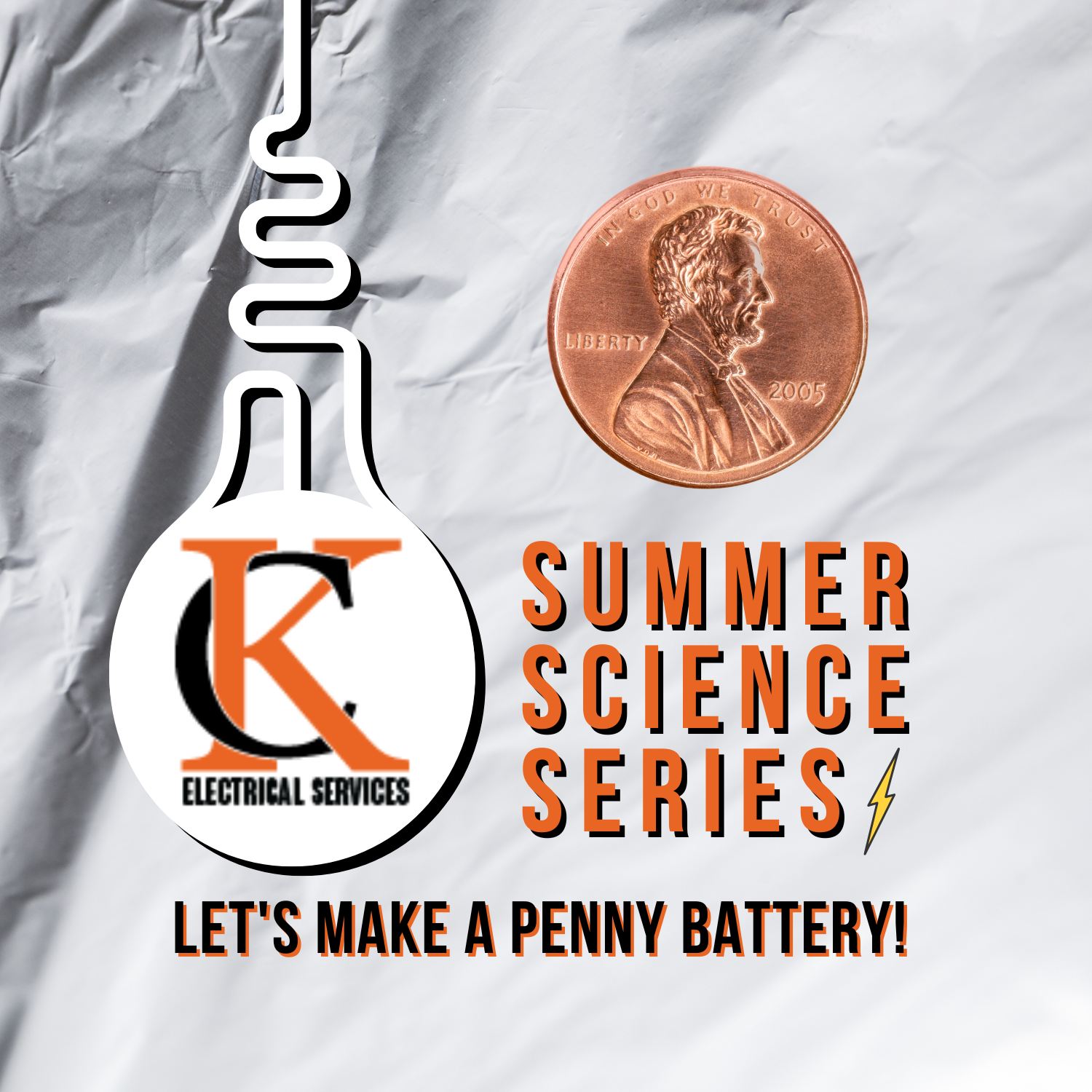Summer Science Series: Let’s Make a Penny Battery!
Can simple pennies (and a few other items) power an LED?
Summer is coming to an end and school will be starting back up in no time. Let’s get another Summer Science Series project in while we can! In this project we’re going to take some regular old pennies and turn them into a battery strong enough to light an LED! You most likely have all the supplies you need lying around the house (and from the other projects we’ve done this summer!) Let’s get started!
You’ll need:
1 Light Emitting Diode (LED) (Click Here) (Do you have one leftover from Play Dough Circuits?)
5-10 Pennies
Aluminum foil
Paper towels
1 Teaspoon Vinegar (any kind)
Duct tape
Alligator clips (These make it easy to connect your battery in a circuit, but you could also use strips of aluminum foil instead.)
Voltmeter (Optional, but if you have one you can measure how much voltage your battery produces.)
Directions:
Step 1. Tear a square piece of aluminum foil about 3” per side. (Exact dimensions are not necessary.) Then fold the aluminum foil into a square about 1” on each side. Exact size is not important, but the square piece of foil should be a little bigger than a penny.
Step 2. Rip a piece of paper towel about the same size as the aluminum foil (3”) and fold it into a similarly sized square (1”).
Step 3. Rip a piece of duct tape that is about the same width or slightly bigger than your paper towel square.
Step 4. Make Your Battery Packet: Lay the strip of duct tape on your table, sticky side up. Place the penny on the duct tape with the edge of the penny slightly over the tape. Then lay the paper towel on top of the penny (lined up with the duct tape edge leaving your penny exposed). Next lay the foil square on top of the paper towel so it does NOT touch the penny, but does hang over the other edge of the duct tape. Fold the duct tape ends over the layers to make your Battery Packet. This will hold your layers together.
Step 5. Add a few drops of vinegar to the paper towel to act as the electrolyte. Your first battery packet is complete. If you have a voltmeter, connect the positive, red lead to the copper penny and the negative, black lead to the aluminum foil. Turn the dial to the lowest voltage setting. Your battery should measure in the vicinity of half a volt.
Step 6. Repeat Step 4 four more times so you have five battery packets altogether.
Step 7. Lay your Battery Packets out on your table with their foil ends pointing to your left and your penny ends on the right. Connect your Battery Packets in a series by attaching the penny of one battery to the aluminum foil of the next with a little bit of duct tape.
Step 8. Attach one of your alligator clips to the end of your Battery Packet Series matching the short end of your LED to the foil end of your packets. Attach your other alligator clip to the penny end of your Battery Packet Series and the long (positive) end of the LED. Remember that an LED is directional, if it doesn’t light up you may have them switched. If your LED still doesn’t light up, try making an additional Battery Packet from Step 4 and adding it to your series.
Step 9. How much is too much? Disconnect the alligator clip from the penny side of your battery packet series. Remove one of your battery packets and then reconnect to the alligator clip (now your series only has 4 Battery Packets). Did your LED still light up? Remove another Battery Packet until the LED no longer lights up.
What’s that got to do with electricity? In nearly all electrical devices, negatively charged particles called electrons flow along a wire to create a current which powers the device. A wire that is not connected to a power source has no reason to create an electrical current. When batteries are connected within a circuit, electrons want to flow from the negative electrode to the positive electrode creating the current used for power. Inside a battery, a separator is placed between the negative electrode and the positive electrode to keep the electrons from flowing directly from one electrode to the other. This forces the electrons to flow along the external wire and power the device. An electrolyte is also placed between the positive and negative electrodes to promote the chemical reactions which will cause the negative electrode to become negatively charged and the positive electrode to become positively charged. In our experiment the aluminum foil is the negative electrode, the penny is the positive electrode, the paper towel is the separator and the vinegar is the electrolyte!
We sure hope you enjoyed the project and have a great rest of your summer!
Disclaimer and Safety Precautions: Kcesinc.com has provided this science activity idea for informational purposes only. Kcesinc.com does not make any guarantee or representation regarding such ideas and is not responsible or liable for any loss or damage, directly or indirectly, caused by your use of such information. Warning is hereby given that not all activities are appropriate for all individuals or in all situations. Implementation should be undertaken only in appropriate settings and with appropriate parental or adult supervision. Reading and following the safety precautions of all materials used in an activity is the sole responsibility of each individual. By accessing the science activity ideas on kcesinc.com, you waive and renounce any claims against kcesinc.com that arise thereof.
